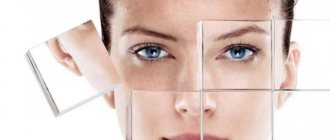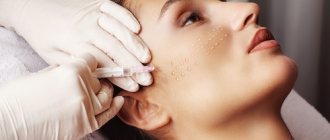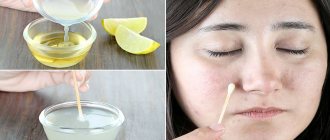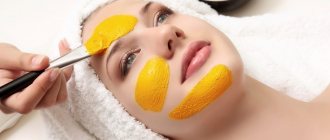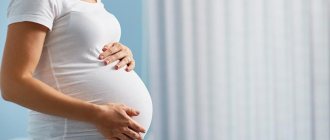Acne* on the back: causes
The main causes of acne on the back include the following [4, 29, 50]:
- Insufficient hygiene. During bathing, not much attention is paid to the back area, although this is one of the seborrheic areas where a large number of sebaceous glands are located.
- Choosing the wrong clothes. Due to wearing synthetic clothing, the skin does not breathe, sweating increases, which can lead to rashes and creates favorable conditions for the growth of bacteria.
- Using the wrong skin care products. Some cosmetics have a comedogenic effect, that is, they clog pores.
- Hormonal imbalance. Often pimples* and acne on the back occur due to the active production of hormones. This often happens to women during menstruation, pregnancy, menopause and adolescents during puberty.
- Stress. Frequent stress and emotional overstrain cause the body to produce large amounts of cortisol and adrenaline, which affect the functioning of the sebaceous glands.
- Taking certain medications. Long-term use of steroids, hormones, and antidepressants can negatively affect the condition of the skin.
Heredity, poor nutrition, prolonged mechanical stress and internal causes, for example, diseases of certain organs and systems also provoke the development of acne. [4, 29, 50]
ACNE IN TEENAGERS
Juvenile acne (blackheads) is the most common skin disease in children and adolescents. The onset of the disease usually occurs in girls aged 12-14 years, in boys at 14-15 years old - due to late puberty. Currently, the myth that the development of acne depends on the nature of nutrition, age hygiene, and sex life has been debunked. Acne is a disease of the sebaceous glands and hair follicles, the functioning of which is associated with the exchange of sex hormones. It is generally accepted that the skin is the main link in the metabolism of sex steroid hormones, and the main “targets” for them are the epidermis, hair follicles and sebaceous glands. Changes in the functional activity of the endocrine system in adolescents at different periods of puberty have their own characteristics. At each stage of development, the sequential inclusion and functioning of endocrine glands, hormones and biologically active substances occurs. They are in close interaction with the synthesis of testosterone (Te) and sex steroid binding globulin (SSBG) secreted by hepatocytes. In addition, the mechanisms of central regulation of the hypothalamic-pituitary system change, which affects the secretion of sex steroid hormones. During puberty, with acne, the ratio between androgens and estrogens is disrupted, and there are twice as many androgens as in healthy individuals. Thus, in the development of acne, the leading role is given to Te and its metabolite - dihydrotestosterone (DTT), the biosynthesis of which is 20-30 times higher compared to healthy people, and in boys this process is more intense than in girls. At the same time, the biosynthesis of some skin enzymes also increases: the activity of 3-hydroxydehydrogenase and 5-reductase is also significantly increased compared to the norm. The latter converts free Te into DHT, which is the main hormone involved in the hypersecretion of the sebaceous gland.
Hypersecretion of sebum is a consequence of high levels of androgens and increased sensitivity of the sebaceous glands to them.
Of decisive importance in this regard are: the direct effect of the increased content of androgens in the blood on the hair follicles and sebaceous glands; increasing the sensitivity of target cells, sex steroid receptors, to circulating androgens; a combination of these two factors.
The secretion of sebum and the size of the sebaceous glands are stimulated by free testosterone of testicular or ovarian origin, dehydroepiandrosterone and androstenedione of adrenal origin. Progesterone, a precursor to testosterone, estrogens and adrenocorticosteroids, has the same effect. Progesterone enhances the secretion of the sebaceous glands due to androgenic and antiestrogenic activity. This fact explains the increase in sebum secretion and the appearance of acne elements before menstruation in women.
An increase in the level of androgens in the blood can be of a temporary physiological nature, for example, during the premenstrual period in women.
Sometimes high levels of free testosterone are caused by decreased levels of sex hormone binding globulin (SHBG). This protein, to which 65% of Te circulating in the blood binds, is synthesized in the liver. The rest combines with albumin, and only 2% of circulating total testosterone remains in the active, unbound form. Therefore, markers of latent hyperandrogenism in males are an increase in the free fraction of Te, and not total testosterone, and a decrease in PSSG (N. E. Kushlinsky, V. A. Samsonov, S. A. Masyukova, I. V. Salamova, 1996).
In women, an important pathogenetic link in hyperandrogenism is the disruption of androgen binding by specific sex steroid binding globulin (SSB), and its concentration is two times higher than in men. This sex difference is explained by the fact that estrogens stimulate, and androgens inhibit, the production of dry eye hormones.
Genetic factors are the trigger point in the development of acne, and, according to K. N. Suvorova (2000), different expressivity and allelic variations of genes that determine the development of the sebaceous glands and their functional ability, and the level of enzymes and hormones to a large extent determine the severity of clinical manifestations . In addition, there is a message about the presence of a nuclear R-factor that determines genetic predisposition. These facts can probably explain the fact that some patients develop quickly passing physiological acne, while others develop more severe forms. According to numerous studies, the likelihood of developing acne in adolescents, if there is a disease in the family or among relatives, ranges from 50-70%.
In addition to androgenic stimulation, hypersecretion of sebum by the sebaceous glands, in most patients the onset of acne is accompanied by hyperkeratinization of the base of the follicle, which leads to blockage of the follicular duct by horny scales and the formation of a microcomedone or a clinically visible closed one (white head); or open (black head). Subsequently, damage and rupture of the duct occurs, with the subsequent development of perifocal inflammation. Retention hyperkeratosis of the acrocrone of the follicle and hyperplasia of the follicular epithelium are decisive in the development of the disease.
Blockage of the sebaceous gland duct entails the cessation of air access, and the resulting oxygen-free conditions are optimal for the proliferation of P. acnes, which is why closed comedones are called a “time bomb.” P. acnes is normally found in sebaceous glands and follicles. The skin also contains staphylococci (epidermal and aureus), micrococci, fungi of the genus Candida and Pytirosporum ovale. Moreover, the number of colonies of microorganisms is proportional to the severity of acne elements: comedones - open and closed, papules, pustules. The outcome of inflammation, as well as the predominance of one of the pathogenetic factors, largely determines the variety of clinical forms of the disease.
An important aspect is the participation of P. acnes in the development of inflammation: they synthesize various chemoattractants that attract leukocytes to the site of inflammation, lipases and a number of enzymes that lead to damage to the follicle wall. They are capable of inducing the production of anti-inflammatory cytokines by mononuclear cells: IL-8, IL-1, TNF, etc., and synthesize antigens that stimulate the production of antibodies, the number of which is increased in patients with acne compared to healthy people. P. acnes produces vasoactive amines like histamine, which increase inflammation. If comedones and papular-pustular rashes are characterized by a high contamination of P. acnes, then with nodular-cystic rashes the amount of P. acnes is minimal. The formation of conglobate acne is probably associated not so much with the number of microorganisms as with a delayed-type hyperreaction (DTH) in the dermis, which may explain the high therapeutic effect of isotretinoin.
The uniqueness of propions largely determines the characteristics of the resolution of inflammatory acne elements. Unlike most strepto- and staphyloderma, inflammatory acne elements resolve more slowly, despite intensive treatment. Torpidity to therapy is due to the resistance of P. acnes to destruction by neutrophils and monocytes, persistence in phagocytic cells, where microorganisms remain viable for a long time, despite antibiotic therapy. In addition, overproduction of sebum does not make it possible to create the necessary concentration of the antibiotic in the ducts of the sebaceous gland. This may explain the prescription of long courses of antibiotics in the treatment of acne.
Thus, genetic predisposition, androgenic stimulation, increased sebum secretion and follicular hyperkeratosis lead to blockage of the sebaceous gland duct with comedones. As a result of the proliferation of P. acnes and the formation of inflammation around the follicle and sebaceous gland, non-inflammatory and inflammatory acne elements (papule, pustule, nodule) are formed. Depending on the nature of the inflammation and the spread of the pathological process in the dermis, the lesions can thicken, infiltrate or abscess with the formation of cysts, which determines the variety of clinical manifestations of the disease. During therapy or spontaneously when acne elements resolve, spots, depigmented scars, hypertrophic or disfiguring keloid scars remain.
Often in adolescents, the onset of the disease is accompanied by the appearance of non-inflammatory and inflammatory acne elements, which are regarded as “physiological” acne. They accompany the pubertal hormonal crisis and, due to their insignificant manifestation (comedones, single papular-pustular acne elements), can spontaneously and completely disappear without treatment. “Clinical” acne occurs in 15% of patients and requires treatment lasting from several months to a year or more or until spontaneous remission is achieved, usually occurring by age 25.
According to the modern classification, the following clinical varieties of juvenile acne are distinguished (G. Plevig, A. Kligman, 1993, 2000).
- Comedonal acne.
- Papular-pustular acne.
- Conglobate acne.
- Inverse acne.
- Lightning acne.
- Mechanical acne.
The development and course of dermatosis depend on the following factors: family (genetic) predisposition, clinical form of the disease, skin type and color. When conducting clinical diagnostics, it is necessary to take into account the following features of acne:
- type of rash (inflammatory or non-inflammatory);
- the number of rashes and their prevalence, size and location;
- severity of complications (pigmentation, excoriation, scars);
- assessment of psychosocial status (anxiety, depression, social maladjustment, etc.);
- if necessary, bacterial culture with determination of sensitivity to antibiotics, studies of hormonal status, skin biopsy for differential diagnosis with other dermatoses;
- patients with severe and often recurrent forms of acne should be examined for the presence of concomitant pathology;
- measurement of the level and rate of sebum excretion (SES);
- creating a trusting relationship between doctor and patient.
In the pathogenesis of acne, primary and secondary factors leading to the development of the disease are distinguished.
Basic principles of treatment: it is necessary to reduce the secretion of the sebaceous gland, reduce inflammation, reduce the colonization of the skin by Propionbacterium acnes and other microorganisms, normalize the mitotic activity of keratinocytes and eliminate blockage of the sebaceous gland duct.
Treatment in many cases is a difficult task, and the use of various therapeutic methods and cosmetics leads only to clinical remission, less often to cure. The choice of therapy is determined not only by the severity of acne, but also by the general condition and psycho-emotional characteristics of the individual.
Currently, recommendations and an algorithm for the pathogenetic treatment of various forms of acne have been developed (XX World Congress of Dermatology, Paris, 2002).
The main objectives in treatment are:
- preventing the formation of comedones (preventive measures and tips for caring for “problem” skin);
- removal of comedones (acne toilet, comedo extraction, tretinoin, retinoic acid, adapalene, salicylic acid, resorcinol);
- reduction in sebum production (retinoids systemically and externally, hormonal drugs - antiandrogens, estrogens, etc.);
- prevention of the opening of comedones, pustules and the development of inflammation (systemic antibiotics and antibacterial drugs for external use);
- combination therapy (systemic antibiotics and topical retinoids or sequential use of glucocorticoids, systemic retinoids, for severe forms of acne);
- preventing the appearance of scars (early initiation of treatment, retinoids, eliminating the possibility of mechanical injury to acne elements);
- improving the appearance of scars only after achieving stable clinical remission (peeling, resurfacing, introduction of implants, corticosteroids; laser therapy, etc.).
The choice of treatment method depends on the following factors: the clinical form of the disease, the nature of acne elements (non-inflammatory, inflammatory), severity (mild, moderate, severe), depth, localization and extent of the process (see Table 1).
For example, comedonal acne is best treated with topical retinoids, while for mild inflammatory acne, retinoids, topical antibiotics, VPO, etc. are indicated. In addition to the severity of acne lesions, complications of dermatosis in the form of scar formation, pigmentation, and also psychosocial problems.
In practice, systemic and topical retinoids are the first choice drugs and were first used for the treatment of acne about 30 years ago by Stuttgen and Baer. First, second and third generation retinoids have general and local effects and are capable of causing a specific biological response as a result of binding and activation of retinoic acid receptors - RAR (retinoid acid receptor).
The mechanism of action of retinoids is to inhibit the processes of keratinization (keratinization), reduce sebum secretion, and also the activity of R. acnes and increased proliferation of epithelial cells of the skin and sebaceous glands, thus affecting all parts of the pathogenesis of the disease.
Indications for external therapy are: mild non-inflammatory and inflammatory forms of acne, as well as non-inflammatory forms of moderate severity.
It is possible to use it in combination with systemic medications for moderate and severe forms of inflammatory acne.
The group of synthetic retinoids of the new (third) generation includes adapalene (Differin), a derivative of naphthoic acid, which has not only the properties of retinoids, but also an anti-inflammatory effect.
The anticomedogenic-comedolytic effect of differin is based on selective interaction with nuclear γ-receptors of epithelial cells (RAR-γ), as a result of which the processes of differentiation of keratinocytes in the infundibulum of the sebaceous gland are improved and the production of sebum is normalized (duct blockage is prevented), as well as the proliferation of skin corneocytes. Thus, differin prevents the formation of microcomedones and promotes the removal of the “keratin plug” (comedogenic and comedolytic effect).
The anti-inflammatory effect of differin has also been studied in vitro and in vivo. It has been established that the drug inhibits the release of cytokines (markers of inflammation) - IL-1, IL-8, IL-12 - through competitive binding to TLR2 receptors of monocytes. In addition, inhibition of lipoxygenase and arachidonic acid, which is involved in the regulation of lipid metabolism in the skin, is observed. The unique pharmacological properties of differin explain its advantages (anti-inflammatory effect, better tolerability) over trans-retinoic and retinoic acid.
One of the disadvantages of external retinoids is their weak effect on hypersecretion of the sebaceous glands, which requires, in some cases, the administration of systemic retinoids (isotretinoin) in adequate doses for severe forms of acne. The drugs are prescribed for a long time (up to three months or more), as well as for prophylactic purposes to prevent the appearance of new acne elements.
For the treatment of conglobate acne, the basic drug is isotretinoin-roaccutane at 0.5-1.0 mg/kg of body weight per day until a total cumulative dose of 120 mg/kg is reached. In addition, treatment with antibiotics gives temporary results, and frequent relapses are observed after their discontinuation. In adolescence, the use of antibiotics should be limited to short courses of no more than four to six weeks, so the emphasis is on the use of topical drugs with multidirectional effects, especially for mild to moderate juvenile acne.
For mechanical acne (pathomymia), psychological rehabilitation, the establishment of trusting relationships with adolescents and the prescription of sedatives in combination with topical pathogenetic drugs are necessary.
For severe fulminant and inverse acne, treatment begins with the prescription of glucocorticoids (prednisolone) in a daily dose of 20-30 mg with a gradual dose reduction by 0.05 mg every five days until the drug is completely discontinued. Prednisolone is prescribed in combination with antibiotics (according to antibiotic sensitivity), and then switched to isotretinoin in adequate doses: 0.5-1.0 mg/kg body weight per day until a total cumulative dose of 120 mg/kg is reached.
Systemic therapy (oral antibiotics, isotretinoin), often in combination with topical medications, is indicated for the treatment of patients with moderate to severe acne. Basic antibiotics are tetracyclines: tetracycline - daily dose of 500 mg twice a day, tetracycline monohydrate - 0.1 mg twice a day, minocycline - 0.1 mg twice a day; macrolides: erythromycin 500 mg twice a day, josamycin: 500 mg twice a day. Alternative drugs for antibiotic intolerance are cotrimoxazole 480 mg twice or timethoprim 100-200 mg from 14 to 21 days. If one antibiotic is ineffective, in some cases it can be replaced with another. However, long-term antibiotic therapy may cause P. acnes resistance, rendering treatment ineffective.
When treating with isotretinoin, it should be remembered that young men with damage to the trunk respond worse to treatment with small doses, so they should be prescribed a starting dose of 1.0 mg/kg, and in older people and sensitive (white) skin - 0.5 mg/kg day, with mandatory monthly biochemical monitoring.
On the pharmaceutical market for topical (external) therapy, various commercial companies offer modern drugs with comedogenic, keratolytic, antibacterial, anti-inflammatory and antiandrogenic properties. One of their disadvantages is their weak effect on hypersecretion of the sebaceous glands, which in some cases requires the use of systemic retinoids (isotretinoin) in adequate doses. The drugs are prescribed for a long time (up to three months or more), as well as for prophylactic purposes - to prevent the appearance of new acne elements.
The basic drugs for external treatment of acne, as well as for systemic treatment, are retinoids, as well as antibacterial drugs - benzoyl peroxide (Baziron AC), local forms of antibiotics (clindamycin, erythromycin, tetracycline, mupirocin, fusidic acid) and systemic antibiotics; alternatives are azelaic acid, hyaluronic acid.
Azelaic acid - a natural dicarboxylic acid (skinorene) has an antimicrobial and anti-inflammatory effect, normalizes keratinization processes, blocks 5-α-reductase and the conversion of testosterone to 5-dihydrotestosterone.
In cosmetology, β-hydroxy acids (salicylic acid) are used, as well as resorcinol in small concentrations (1-3%), α-hydroxy acids (AHA) - malic, tartaric, citrus, lactic and glycolic acids. It should be remembered that topical antibiotics are not recommended to be combined with systemic antibiotics.
The antibacterial drug baziron AS, containing benzoyl peroxide, does not develop resistance in microorganisms, so it can be used for long courses of treatment, as well as as maintenance therapy. In addition, the risk of developing microbial resistance to antibiotics is reduced when they are combined with benzoyl peroxide [8]. Water-based gel for external use, Baziron AS, in addition to antibacterial and anti-inflammatory, also has comedolytic and moisturizing effects. The combined preparation Baziron AS contains an “acrylic copolymer - glycerin” system, which ensures controlled absorption of sebum and skin hydration: the gel is indicated for all skin types, including sensitive ones.
An important place in the rehabilitation of patients with acne and the prevention of the development of complications is given to compliance with recommendations for facial skin care (acne-toilet) using maintenance therapy with topical retinoids, cleansing lotions, gels that do not have a comedogenic effect. Each of these drugs for topical and systemic action has its own advantages and side effects, so it is very important to follow the recommendations given by your doctor.
S. A. Masyukova , Doctor of Medical Sciences, Professor Z. S. Bekmagomaeva, S. A. Razumova, N. V. Gunina SIUV MO RF, Moscow
Acne* on the back: which organ may not be working properly?
There is a myth that the location of acne is related to the functioning of a particular organ. Here are the organs that acne* on the back is supposedly responsible for [208]:
- liver (hepatitis);
- organs of the gastrointestinal tract;
- genitourinary system;
- endocrine system.
In fact, it is impossible to determine which organ hurts based on acne* on the back, because this hypothesis has no scientific evidence. Therefore, when treating rashes, specialists do not rely on this theory.
Mechanism of acne appearance
All human stress does not pass without a trace. Insomnia, intestinal upset, sweating and acne are the most common manifestations of psychosomatics. There are three main mechanisms for the appearance of skin rashes:
- The body reacts to constant stress by actively releasing protein antibodies. This is a nonspecific allergic reaction, as a result of which pimples appear.
- The digestive system is regulated on many levels, from hormones and enzymes to blood flow and muscles. Therefore, under stress, its work is disrupted, which provokes the accumulation of toxins. Such poisoning of the body from the inside for a long time leads to acne (most often on the forehead and in the area of the nasolabial triangle).
- When a person constantly experiences discomfort or negative emotions, immunity decreases. As a result, all bacteria and pathogens actively enter through unprotected skin. Immediately the body comes to its senses and sends “help” to the penetration points - white blood cells, which kill bacteria and remove them in the form of pimples.
View this post on Instagram
Publication from NASTYA. Love lives here (@nastyaolzhabaeva)
These mechanisms are very conditional, and do not work for all people and not always. Some people live under stress and feel great, while for others psychosomatics causes acne after two or three failures.
How to treat acne* on the back?
Treatment is prescribed by a specialist, based on the clinical picture and severity of acne. For mild acne, the emphasis is on external therapy and the use of topical medications. For moderate acne, combination treatment is necessary; for severe acne, systemic medications are mainly used. [18]
It is also recommended to adhere to the following rules:
- To cleanse the skin, use products without preservatives, oils, or fragrances;
- during periods of acne remission, scrub or use peelings for exfoliation;
- after playing sports or strenuous physical activity, be sure to take a shower immediately;
- wear comfortable clothes made of breathable materials;
- change bed linen and towels every week.
Acne treatment should be regular. You should not interrupt or abandon it, as this may reduce the effectiveness of therapy.
Types of acne and their meaning
It is possible to establish psychosomatics only by discarding the standard causes of the rash - staphylococcus and streptococcus, prickly heat, diseases of the digestive system, allergies. If a doctor or person independently begins to suspect that psychosomatics has caused acne in the back area, then now you can begin to look for the cause. And the nature of the skin rashes will help with this:
- A mild, small rash indicates ongoing problems. These may even be small things, but if because of them a person is nervous and cannot calm down, then the skin problem will not be solved.
- Acne indicates low self-esteem. A person does not accept himself, is ashamed, is afraid to appear real.
- Shy and shy people have pimples of normal size, do not fester, and their number depends on how much the person wants to abstract himself from others.
- Rare pimples in certain areas indicate a dislike of change.
In addition to the type of acne, for diagnosis you need to look at the frequency and quantity of their appearance. If after a certain situation (a scandal at home, the boss shouted, failed to make friends with someone) there are more skin rashes, then this particular factor is psychosomatic. Everyone has their own stresses, fears and difficulties in life. Therefore, you need to immediately assess the character, find weaknesses in order to understand what caused the illness.
Acne inflammation on the back as a consequence of psychosomatics
Hygiene and additional care for men's backs
Dirt and dead skin cells increase the inflammatory process, and they also infect healthy areas of the skin surface.
To get rid of acne as quickly as possible, you must strictly observe hygiene:
- Disposable towels - use these to prevent bacteria that accumulate on the towel from spreading throughout your body. If you prefer ordinary ones, then they should be changed after each use;
- Cream - when using cream, do not touch it with your hands, this will only promote the growth of bacteria. Scoop up the cream using cosmetic spatulas;
- Cleansing the skin - it is necessary to cleanse the skin thoroughly, so that dead cells will not accumulate on the man’s back and multiply bacteria;
- Cleansers - do not use skincare products that contain heavy fats. This helps to clog pores.
Normalizing nutrition will help
To treat acne in a teenager, you will need to follow a diet for at least some time. No strict restrictions, but only normalization of nutrition.
That is, if your offspring ate French fries, chips, and deep-fried foods, then this has to end.
It is necessary to exclude from the diet all deep-fried or high-fat foods. Fried and at the same time fatty foods help to strengthen the work of the already active sebaceous glands.
In addition, it is necessary to exclude spicy foods - they irritate the sweat glands. What enhances their work? Another important dietary prohibition is sweet foods.
It is better to eliminate sugar altogether for a while, and instead offer the teenager fructose or honey.
Prevention
It has long been known that it is easier to prevent a disease than to treat it.
To do this, it is necessary to carry out prevention:
- Always cleanse your skin thoroughly and also moisturize it;
- Follow your diet , excluding harmful foods;
- Do not be under prolonged stress , this has a negative effect on the skin of the back;
- To improve the general condition of the skin, take a bath with a series or decoction of chamomile;
- Wear clothes made from natural fibers and choose quality bedding.
It is necessary to lead an active lifestyle, move more, walk in the fresh air and play sports.
Where does the rash form?
If we talk about the causes of a rash on the skin of a teenager who has not yet turned one year old, they are associated with:
- Heat rash;
- Allergic reactions;
- Diaper rash.
Even a teenager can often suffer from heat rash. It is represented by a scattering of small blisters that are red in color and localized inside the skin folds.
Diaper rash may also occur due to skin sensitivity in a teenager. This is wet and already swollen skin, which is located in different folds. Sometimes they appear as a result of a fungal infection and appear as flaky skin with white deposits. When it occurs in the buttock area, diaper rash sometimes becomes erythema gluteus in the form of a cluster of small erosions with nodules.
An important cause of a rash in a teenager can be an allergy associated with food or medications taken. Then the skin of the face suffers: for example, a milk scab, just as an allergy to mother's milk causes redness and roughness of the skin. The skin on the head under the hair may also suffer - scales will appear and begin to peel off. Finally, even areas of the skin in the back and chest can be affected by hives, which are expressed as itchy pink blisters.
The main thing is to detect the rash in time and not ignore it, identifying the cause and starting the correct treatment.
